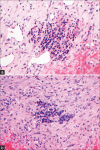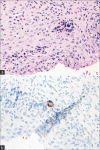Hidden treasures: Incidental findings in two cases of chronic subdural hematoma
- PMID: 35855153
- PMCID: PMC9282790
- DOI: 10.25259/SNI_828_2021
Hidden treasures: Incidental findings in two cases of chronic subdural hematoma
Abstract
Background: Extramedullary hematopoiesis (EMH) and plasmacytomas occurring within the cranium are rare entities.
Case description: We review two cases in which patients presented with subdural hematoma and underwent evacuation. On routine histopathologic examination of their membranes, both patients were subsequently found to have focal EMH, as well as a clonal plasma cell proliferation in one case.
Conclusion: EMH is rare and usually found in individuals with profound and chronic anemia. However, this entity may be more common in chronic subdural hematomas. Solitary extraosseous plasmacytoma is exceedingly rare in the cranium, and its presence in chronic subdural hematoma membranes is of uncertain significance. The cytokine milieu that promotes organization of chronic subdural hematomas may play a role in the establishment of both of entities in this location.
Keywords: Case report; Extramedullary hematopoiesis; Plasmacytoma; Subdural hematoma.
Copyright: © 2022 Surgical Neurology International.
Conflict of interest statement
There are no conflicts of interest.
Figures





Similar articles
-
Solitary Extramedullary Plasmacytoma Mimicking Acute Subdural Hematoma.World Neurosurg. 2018 Dec;120:521-524. doi: 10.1016/j.wneu.2018.09.151. Epub 2018 Sep 27. World Neurosurg. 2018. PMID: 30268553
-
[Intracranial extramedullary hematopoiesis following bilateral chronic subdural hematoma in a patient with idiopathic myelofibrosis].Rinsho Ketsueki. 2005 Oct;46(10):1160-2. Rinsho Ketsueki. 2005. PMID: 16440782 Japanese.
-
Extramedullary hematopoiesis: an unusual finding in subdural hematomas.Case Rep Pathol. 2011;2011:718585. doi: 10.1155/2011/718585. Epub 2011 Sep 27. Case Rep Pathol. 2011. PMID: 22937391 Free PMC article.
-
Meningioma Presenting with Spontaneous Subdural Hematoma: A Report of Two Cases and Literature Review.World Neurosurg. 2019 Jul;127:150-154. doi: 10.1016/j.wneu.2019.03.248. Epub 2019 Apr 1. World Neurosurg. 2019. PMID: 30947005 Review.
-
Multiple Spinal Chronic Subdural Hematomas Associated with Thoracic Hematomyelia: A Case Report and Literature Review.World Neurosurg. 2019 Nov;131:95-103. doi: 10.1016/j.wneu.2019.07.209. Epub 2019 Aug 5. World Neurosurg. 2019. PMID: 31394354 Review.
References
-
- Duerinck J, Van Rompaey K, Moens M, Ampe B, De Smet K, Michotte A, et al. Development of dural plasmacytoma after evacuation of chronic subdural hematoma: Case report. Clin Neurol Neurosurg. 2012;114:1322–5. - PubMed
-
- Eskazan AE, Ar MC, Baslar Z. Intracranial extramedullary hematopoiesis in patients with thalassemia: A case report and review of the literature. Transfusion. 2012;52:1715–20. - PubMed
-
- Firsching R, Müller W, Thun F, Boop F. Clinical correlates of erythropoiesis in chronic subdural hematoma. Surg Neurol. 1990;33:173–7. - PubMed
-
- Kuhn E, Dorji T, Rodriguez J, Rosai J. Extramedullary erythropoiesis in chronic subdural hematoma simulating metastatic small round cell tumor. Int J Surg Pathol. 2007;15:288–91. - PubMed
